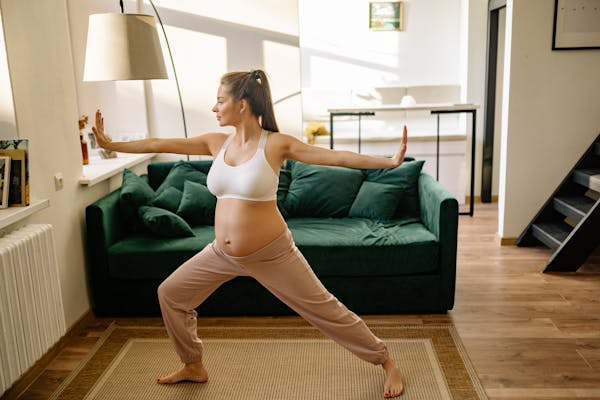Table of Contents
Introduction
Pregnancy is a wonderful yet challenging period for many women, and it has its unique set of physical, mental, and emotional changes. As your body undergoes many changes, you must find ways to stay active and balanced.
Pregnancy yoga can be an excellent tool in keeping you healthy and well during this special journey. This is a comprehensive guide that will walk you through everything you need to know about pregnancy yoga, from its benefits to the best poses, safety tips, and expert advice.

1. What Is Pregnancy Yoga?
Definition and Concept: Pregnancy yoga is a form of yoga specifically designed for expectant mothers. It focuses on gentle and mindful movements, breathing exercises, and poses that are safe for the body during pregnancy. Goals of Pregnancy Yoga:
Maintain flexibility and strength
Relieve discomforts such as back pain, swelling, and nausea
Enhance relaxation and reduce stress
Improve circulation and breathing techniques for labor
Increase body awareness and promote a deeper connection with the baby
2. Benefits of Pregnancy Yoga
Physical Benefits:
Reduces Back Pain: Many women experience back pain during pregnancy. Yoga helps stretch and strengthen muscles, which can alleviate discomfort.
Flexibility is increased by the soft stretches in pregnancy yoga. These movements are particularly helpful for flexible movement in the hips, pelvis, and lower back.
Improves Blood Circulation: Blood-flow promoting poses help to minimize swelling and increase circulation in the body.
Rehabilitative Posture: Pregnancy can change your posture in order to make room for the baby in the abdominal cavity. Pregnancy yoga helps maintain natural alignment that reduces strain on the back and neck muscles.
Psychological and Emotional Benefits:
Relieves Stress: Pregnancy can be very overwhelming. Yoga provides a safe space to unwind and manage anxiety, making you feel calm and centered.
Increases Mental Clarity: Regular practice of yoga supports a positive mindset and helps combat mood swings.
Improves Sleep Quality: The relaxation techniques taught in pregnancy yoga can help you achieve a restful night’s sleep.
Benefits for Labor and Delivery:
Prepares for Birth: Breathing exercises and positions learned in pregnancy yoga can help with pain management during labor.
Strengthens the Pelvic Floor: Yoga poses help to strengthen the muscles of the pelvic floor, which is crucial during childbirth.
Enhances Breathing Techniques: Learning deep and mindful breathing during pregnancy yoga can help during labor by managing pain and keeping you focused.
3. When to Start Pregnancy Yoga
The Right Time:
It’s safer to begin pregnancy yoga in your second trimester when the risk of miscarriage is lower and body adaptation to the early stages of pregnancy has occurred.
But if you are practicing yoga for the first time or have certain health conditions, consult your doctor before you start the activity. For Advanced Stages of Pregnancy:
While pregnancy yoga is helpful during the second and third trimesters, be sure to listen to your body and not push yourself beyond your limits as the baby grows.


4. Key Yoga Poses for Pregnancy
1. Cat-Cow Pose (Marjaryasana-Bitilasana)
How to Do It: Begin on your hands and knees with your wrists in a line with your shoulders and your knees in a line with your hips. Inhale; arch your back, lifting your head and tailbone (Cow). Exhale; round your spine, tucking your chin into your chest (Cat).
Benefits: This pose has the ability to improve spinal mobility while easing back pain and opening up the chest.
2. Child’s Pose (Balasana)
How to Do It: Start on your knees, sitting on your heels. Lower your torso down to the mat, extending your arms forward or alongside your body. Rest your forehead on the ground.
Benefits: This relaxing pose gently stretches the back, hips, and thighs, and induces relaxation.
3. Downward-Facing Dog (Adho Mukha Svanasana)
How to Do It: Begin in a tabletop position with hands and feet on the mat. Lift your hips toward the ceiling, extending your arms and legs into an inverted “V.”
Benefits: Strengthens the arms, legs, and core while opening up the chest and improving circulation.
4. Warrior II (Virabhadrasana II)
How: Stand with your feet wide apart. Turn one foot out 90 degrees and bend that knee. The other leg is straight. Extend your arms out to your sides, with your palms down. Look over your front hand.
Strengthens legs, opens the hips, and encourages balance and focus.
5. Hip Opener Pose (Supta Baddha Konasana)
How to Do It: Sit with your legs bent and feet together. Slowly lower your back to the floor, keeping your feet together. Let your knees fall apart, and rest your arms at your sides.
Benefits: Opens the hips and stretches the inner thighs, which can help alleviate discomfort in the pelvis.
6. Seated Side Stretch
How to Do It: Sit on the floor with your legs straight out in front of you. Reach one arm over your head and lean forward to the side, stretching the torso.
Benefits: Stretches the side body and helps to open up the ribcage, increasing lung capacity.


5. Pregnancy Yoga Breathing Techniques
1. Ujjayi Breath (Victorious Breath)
How to Do It: Inhale and exhale slowly through the nose, constricting the throat slightly to create a soft, ocean-like sound. This is particularly helpful for focusing and grounding.
Benefits: Promotes relaxation, improves circulation, and calms the nervous system.
2. Dirga Pranayama (Three-Part Breath)
How to Do It: Inhale deeply, filling the belly, ribcage, and chest in three parts. Exhale slowly, releasing the breath in reverse order.
Benefits: It increases lung capacity and brings mental clarity and relaxation.
3. Nadi Shodhana (Alternate Nostril Breathing)
How to Do It: Close one nostril with your thumb, inhale through the other nostril, then close it and exhale through the opposite nostril. Repeat the process.
Benefits: Calms the mind, balances energy, and reduces stress.
6. Safety Tips for Pregnancy Yoga
1. Listen to Your Body: Pay attention to how your body feels. If it feels uncomfortable or painful, stop right away, adjust the pose, or take a break.
2. Avoid Deep Twists and Overstretching: Steer clear of poses that require deep twisting or overstretching of your abdomen, especially in later stages of pregnancy.
3. Use Props for Support: Bolsters, blankets, and blocks can provide extra support and make poses more comfortable, especially as your body changes.
4. Stay Hydrated: Drink plenty of water before, during, and after your practice to stay hydrated and support overall well-being.
5. Avoid Laying on Your Back After 16 Weeks: Do not lie on your back after the 16th week of pregnancy because it can cut off the blood supply to the baby.
6. Choose a Certified Instructor: If you are a beginner, work with a certified instructor in pregnancy yoga to ensure that you are practicing safely and effectively.
7. Creating a Pregnancy Yoga Routine
Morning Routine:
Start with morning gentle stretches to relieve stress and start your day in the right mindset.
Practice deep breathing exercises to refresh and align your self for the new day.
Evening Practice
Calming pose – Child’s Pose, Seated Side Stretch, Supta Baddha Konasana
Before resting, the body is being prepared through calming poses
Concentrate on breath techniques to unwind and clear your mind from all stress during the day
Weekly Routine:
Ideally, this practice should take place 2–3 times a week if your schedule is good and there is energy.
Consistency really helps bring about most of the benefits that can arise from pregnancy yoga.
8. How Pregnancy Yoga Help Mental Health
Mindfulness: Pregnancy yoga facilitates mindfulness. Staying in a present and tuned-in body awareness and relationship can help you lose anxiety and stress toward better mental health.
Emotional Well-being: The practice of yoga creates a sense of community and support, as many pregnant women attend classes together. This emotional connection can reduce feelings of isolation and provide emotional support.
Empowerment: Pregnancy yoga promotes a sense of empowerment by helping you understand your body and its abilities, fostering confidence as you approach labor and childbirth.


9. Considerations and Precautions
Consult Your Healthcare Provider: Before you begin your yoga practice, consult your doctor or midwife, especially if you have any health concerns such as gestational diabetes, preeclampsia, or a history of premature labor.
Adjust as Needed: Every pregnancy is unique and your body will change over time. Modify poses to accommodate your growing belly and any physical discomforts.
10. Conclusion
Pregnancy yoga is not merely a physical exercise but a holistic and comprehensive health well-being approach during pregnancy.
More than helping with preparing for labor, relieving discomfort, reducing stress, and deepening the bond between a mother and her baby, pregnancy yoga has its advantages and benefits for both body and mind.
Therefore, by using safe and gentle yoga poses and techniques combined with mindfulness and breathing methods, you can have a healthier and peaceful experience.
Remember that each pregnancy is unique, so listen to your body and seek advice from healthcare professionals to develop a practice that works best for you.
Whether you are new to yoga or a seasoned practitioner, pregnancy yoga offers a wealth of benefits that will guide you through this transformative journey.
